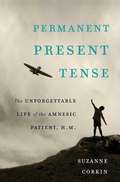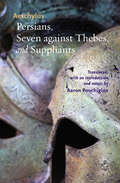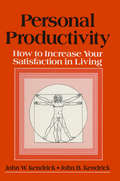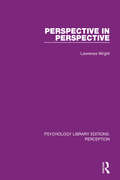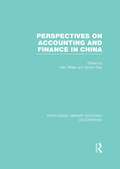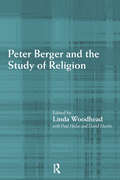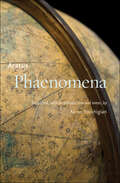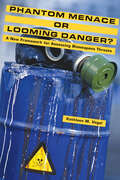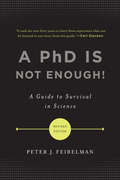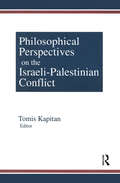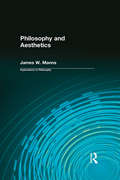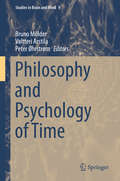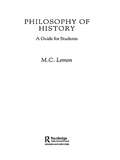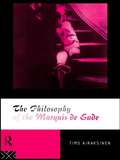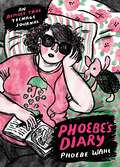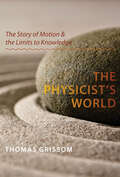- Table View
- List View
Permanent Present Tense: The Unforgettable Life of the Amnesic Patient, H. M.
by Suzanne CorkinIn 1953, 27-year-old Henry Gustave Molaison underwent an experimental "psychosurgical” procedure-a targeted lobotomy-in an effort to alleviate his debilitating epilepsy. The outcome was unexpected-when Henry awoke, he could no longer form new memories, and for the rest of his life would be trapped in the moment.But Henry's tragedy would prove a gift to humanity. As renowned neuroscientist Suzanne Corkin explains in Permanent Present Tense, she and her colleagues brought to light the sharp contrast between Henry's crippling memory impairment and his preserved intellect. This new insight that the capacity for remembering is housed in a specific brain area revolutionized the science of memory. The case of Henry-known only by his initials H. M. until his death in 2008-stands as one of the most consequential and widely referenced in the spiraling field of neuroscience. Corkin and her collaborators worked closely with Henry for nearly fifty years, and in Permanent Present Tense she tells the incredible story of the life and legacy of this intelligent, quiet, and remarkably good-humored man. Henry never remembered Corkin from one meeting to the next and had only a dim conception of the importance of the work they were doing together, yet he was consistently happy to see her and always willing to participate in her research. His case afforded untold advances in the study of memory, including the discovery that even profound amnesia spares some kinds of learning, and that different memory processes are localized to separate circuits in the human brain. Henry taught us that learning can occur without conscious awareness, that short-term and long-term memory are distinct capacities, and that the effects of aging-related disease are detectable in an already damaged brain.Undergirded by rich details about the functions of the human brain, Permanent Present Tense pulls back the curtain on the man whose misfortune propelled a half-century of exciting research. With great clarity, sensitivity, and grace, Corkin brings readers to the cutting edge of neuroscience in this deeply felt elegy for her patient and friend.
Persians, Seven against Thebes, and Suppliants (Johns Hopkins New Translations from Antiquity)
by AeschylusAaron Poochigian’s new translations of Aeschylus’s earliest extant plays provide the clearest rendering yet of their formal structure. The distinction between spoken and sung rhythms is as sharp as it is in the source texts, and for the first time readers in English can fully grasp the balanced, harmonious arrangement of choral odes. The importance of these works to the history of drama and tragedy and to the history of classical literature is beyond question, and their themes of military hubris and foreign versus native are deeply relevant today. Persians offers a surprisingly sympathetic portrayal of the Athenians’ most hated enemy; in Seven against Thebes Argive invaders, though no less Greek than the Thebans themselves, are portrayed as barbarians; and in Suppliants the city of Argos is called upon to protect Egyptian refugees. Based on textual evidence and the archaeological remains of the Theater of Dionysus at Athens, Poochigian’s introductory overview of stage properties and accompanying stage directions allow readers to experience the plays as they were performed in their own time. He is most careful in his translations of the plays’ choral odes. Instead of rendering them with little or no form, Poochigian has preserved the comprehensive structures Aeschylus himself employed. Readers are thus able to recognize Aeschylus as a master of poetry as well as of drama. Poochigian’s translations are the most accurate renditions of the poetry and dramaturgy of the original works available. Intended to be both read as literature and performed as plays, these translations are lucid and readable, while remaining staunchly faithful to the texts.
The Persistence of History: Cinema, Television and the Modern Event (AFI Film Readers)
by Vivian SobchackThe Persistence of History examines how the moving image has completely altered traditional modes of historical thought and representation. Exploring a range of film and video texts, from The Ten Commandments to the Rodney King video, from the projected work of documentarian Errol Morris to Oliver Stone's JFK and Spielberg's Schindler's List, the volume questions the appropriate forms of media for making the incoherence and fragmentation of contemporary history intelligible.
Personal Finance
by Rachel Siegel Carol YachtPersonal Finance by Rachel Siegel and Carol Yacht is a comprehensive Personal Finance text which includes a wide range of pedagogical aids to keep students engaged and instructors on track. If you would like to hear Rachel talk about her book, and the Personal Finance course listen here to her podcast. This book is arranged by learning objectives. The headings, summaries, reviews, and problems all link together via the learning objectives. This helps instructors to teach what they want, and to assign the problems that correspond to the learning objectives covered in class. Personal Finance includes personal finance planning problems with links to solutions, and personal application exercises, with links to their associated worksheet(s) or spreadsheet(s). In addition, the text boasts a large number of links to videos, podcasts, experts' tips or blogs, and magazine articles to illustrate the practical applications for concepts covered in the text. Finally, the modular nature of the chapters lends itself to the Flat World Knowledge publishing model allowing instructors to adapt the textbook to the exact needs of their specific class and student body.
Personal Productivity
by John W. Kendrick J. B. KendrickThe author explores the careers and private lives of the first two African-American boxing champions in order to define the history of race relations and the black press at the time. The major events and fights are organized around the themes of segregation and the significance to black Americans.
Perspective in Perspective: Material Culture In Formation (Psychology Library Editions: Perception #35)
by Lawrence WrightOriginally published in 1983, this book is about the way we see things – or think we do, which is by no means the same – and about the ways in which we have tried to reproduce that visual concept in diagrams, pictures, photographs, films and television. Whatever the medium, if any degree of realism is intended, some use of perspective is inevitable, and some understanding of it can aid the appreciation of the result. But here the technicalities of perspective geometry are treated as far as possible non-technically, by a common-sense approach. Students, would-be artists or architects, are warned in the Preface that they will travel second-class in the author’s train of thought (the ‘general reader’ coming first), but they may well find the journey worthwhile in that it provides a background to a subsequent, more detailed studies. Lawrence Wright shows that every form of perspective representation has some innate falsity, but that most such forms offer an adequate makeshift; that rules of geometry often need to be bent; that labour-saving dodges and shortcuts exist. As he says, perspective drawing, like politics, is an art of the possible. In reading this book, beginners may find it all simpler than they had supposed, though the established expert may in some interesting respects find just the opposite. The general reader may thereafter find himself seeing things – and representations of them – in a new light.
Perspectives on Accounting and Finance in China (Routledge Library Editions: Accounting)
by John Blake Simon GaoThe rush of entrepreneurial activity in China has been watched with interest by the financial world. This book, the result of an international symposium on Chinese accounting and financial management, assesses the little-known accounting scene in China which up until 1978 remained behind closed doors. Divided into four sections, the volume covers: Chinese perspectives on accounting the business and financial structure of China, including the re-emergence of a Chinese stock market the regulatory framework of accounting in China and comparisons with international accounting standards; the impact of current reforms in Chinese accounting practice the emergence of a new accounting profession in China. The concluding chapter provides an overview of the cultural context of the reforms which took place in the 1990s. By using comparisons with other Asian countries’ accounting systems, like Taiwan, the contributors to the volume give an analysis of the state of accountancy in China during the 1990s.
Perspectives on Modern China: Four Anniversaries (Studies On Modern China)
by Kenneth Lieberthal Joyce Kallgren Roderick MacFarquhar Frederic WakemanThe conveners (the editors of this book) of the September 1989 Four Anniversaries China Conference in Annapolis, asked the contributors to look back from that point in time to consider four major events in modern Chinese history in the perspective of the rapid changes that were shaping the Chinese society, economy, polity, and sense of place in the world in the 1980s, a time when China was making rapid strides toward becoming more integrated with the outside world. With contributions by distinguished scholars in the field, the four anniversaries considered are the High Qing, the May Fourth Movement, forty years of communism in China, and ten years of the Deng era.
Peter Berger and the Study of Religion
by Paul Heelas David Martin Linda WoodheadPeter Berger is the most influential contemporary sociologist of religion. This collection of essays is the first in-depth study of his contribution to the field, providing a comprehensive introduction to his work and to current thought in the study of religion. Themes addressed include: * Berger on religion and theology* Religion, spirituality and the discontents of modernity* Secularization and de-secularizationA postscript by Peter Berger, responding to the essays, completes this overview of this major figure's work.
Phaenomena (Johns Hopkins New Translations from Antiquity)
by AratusAfter the Iliad and the Odyssey, the Phaenomena was the most widely read poem in the ancient world. Its fame was immediate. It was translated into Latin by Ovid and Cicero and quoted by St. Paul in the New Testament, and it was one of the few Greek poems translated into Arabic. Aratus’ Phaenomena is a didactic poem—a practical manual in verse that teaches the reader to identify constellations and predict weather. The poem also explains the relationship between celestial phenomena and such human affairs as agriculture and navigation. Despite the historical and pedagogical importance of the poem, no English edition suitable for students and general readers has been available for decades. Aaron Poochigian’s lively translation makes accessible one of the most influential poets of antiquity. Poochigian's interpretation of the Phaenomena reestablishes the ancient link between poetry and science and demonstrates that verse is an effective medium for instruction. Featuring references to Classical mythology and science, star charts of the northern and southern skies, extensive notes, and an introduction to the work’s stylistic features and literary reception, this dynamic work will appeal to students of Ancient Greece who want to deepen their understanding of the Classical world.
Phantom Menace or Looming Danger?: A New Framework for Assessing Bioweapons Threats
by Kathleen M. VogelThe horrifying terrorist attacks on September 11, 2001, and the anthrax strikes that soon followed gave the United States new reason to fear unconventional enemies and atypical weapons. These fears have prompted extensive research, study, and planning within the U.S. military, intelligence, and policy communities regarding potential attacks involving biological weapons. In Phantom Menace or Looming Danger?, Kathleen M. Vogel argues for a major shift in how analysts assess bioweapons threats. She calls for an increased focus on the social and political context in which technological threats are developed.Vogel uses case studies to illustrate her theory: Soviet anthrax weapons development, the Iraqi mobile bioweapons labs, and two synthetic genomic experiments. She concludes with recommendations for analysts and policymakers to integrate sociopolitical analysis with data analysis, thereby making U.S. bioweapon assessments more accurate. Students of security policy will find her innovative framework appealing, her writing style accessible, and the many illustrations helpful. These features also make Phantom Menace or Looming Danger? a must-read for government policymakers and intelligence experts.
Pharmacology for the Primary Care Provider - E-Book
by Marilyn Winterton Edmunds Maren Stewart MayhewWritten by and for nurse practitioners, and also suitable for physician’s assistants, Pharmacology for the Primary Care Provider, 4th Edition focuses on what you need to know to safely and effectively prescribe drugs for primary care. An emphasis on patient teaching helps you gain patient adherence to prescribed drug regimens, and guidelines for health promotion help in maintaining and improving your patients’ health. Now in full color, this edition expands the book's emphasis on the QSEN priorities of safety and evidence-based practice, and adds coverage of new drugs, new drug classes, and new therapeutic drug uses. Written by leading nurse practitioner authorities Marilyn Winterton Edmunds and Maren Stewart Mayhew, Pharmacology for the Primary Care Provider teaches principles of pharmacotherapeutics using today’s most commonly used drugs. A Key Drugs focus highlights the most commonly used and most representative drugs of each major drug class — with particular emphasis on the top 100 most commonly prescribed drugs.Emphasis on patient teaching helps you communicate with patients and family caregivers to promote adherence to the drug regimen.Emphasis on health promotion describes how to help patients stay well and improve their health, including coverage of immunizations and biologicals, vitamins, weight management, and smoking cessation. Evidence-Based Decision-Making and Treatment Guidelines chapter (11) provides practical guidelines for using the best current research evidence to make decisions about the care of individual patients.Extensive coverage of drug therapy for special populations such as geriatric and pediatric patients includes considerations related to age, pregnancy, race, and other factors.UNIQUE! Coverage of prescriptive practice includes topics such as prescriptive authority, role implementation, and the role of nurses (NPs, CNMs, CRNAs, and CNSs) and physician assistants in writing prescriptions. NEW! Full-color design and illustrations highlight the most important content.DRUG UPDATES reflect the latest FDA-approved drugs, drug classes, and therapeutic uses.Expanded emphasis on the QSEN priorities of safety and evidence-based practice helps you eliminate drug prescribing errors with color-highlighted Safety Alerts! and NEW Clinical Practice Alerts!NEW section on male hormone replacement therapies adds coverage of men to that for women. Updated evidence-based prescribing information reflects the latest national clinical practice guidelines and evidence-based treatment guidelines, including the latest clinical treatment guidelines for diabetes. NEW! Complementary and Alternative Products tables highlight interactions with drugs, and are emphasized with a distinctive icon.Updated Drug Overview tables are enhanced with color as well as Top 100 icons that highlight the most commonly prescribed drugs.
A PhD Is Not Enough!: A Guide to Survival in Science
by Peter J. FeibelmanEverything you ever need to know about making it as a scientist.Despite your graduate education, brainpower, and technical prowess, your career in scientific research is far from assured. Permanent positions are scarce, science survival is rarely part of formal graduate training, and a good mentor is hard to find.In A Ph.D. Is Not Enough!, physicist Peter J. Feibelman lays out a rational path to a fulfilling long-term research career. He offers sound advice on selecting a thesis or postdoctoral adviser; choosing among research jobs in academia, government laboratories, and industry; preparing for an employment interview; and defining a research program. The guidance offered in A Ph.D. Is Not Enough! will help you make your oral presentations more effective, your journal articles more compelling, and your grant proposals more successful.A classic guide for recent and soon-to-be graduates, A Ph.D. Is Not Enough! remains required reading for anyone on the threshold of a career in science. This new edition includes two new chapters and is revised and updated throughout to reflect how the revolution in electronic communication has transformed the field.
Phenomenology of Perception
by Maurice Merleau-PontyFirst published in 1945, Maurice Merleau-Ponty’s monumental Phénoménologie de la perception signalled the arrival of a major new philosophical and intellectual voice in post-war Europe. Breaking with the prevailing picture of existentialism and phenomenology at the time, it has become one of the landmark works of twentieth-century thought. This new translation, the first for over fifty years, makes this classic work of philosophy available to a new generation of readers. Phenomenology of Perception stands in the great phenomenological tradition of Husserl, Heidegger, and Sartre. Yet Merleau-Ponty’s contribution is decisive, as he brings this tradition and other philosophical predecessors, particularly Descartes and Kant, to confront a neglected dimension of our experience: the lived body and the phenomenal world. Charting a bold course between the reductionism of science on the one hand and "intellectualism" on the other, Merleau-Ponty argues that we should regard the body not as a mere biological or physical unit, but as the body which structures one’s situation and experience within the world. Merleau-Ponty enriches his classic work with engaging studies of famous cases in the history of psychology and neurology as well as phenomena that continue to draw our attention, such as phantom limb syndrome, synaesthesia, and hallucination. This new translation includes many helpful features such as the reintroduction of Merleau-Ponty’s discursive Table of Contents as subtitles into the body of the text, a comprehensive Translator’s Introduction to its main themes, essential notes explaining key terms of translation, an extensive Index, and an important updating of Merleau-Ponty’s references to now available English translations. Also included is a new foreword by Taylor Carman and an introduction to Merleau-Ponty by Claude Lefort. Translated by Donald A. Landes.
Philosophical Perspectives on the Israeli-Palestinian Conflict
by Tomis KapitanThis volume addresses a number of philosophical problems that arise in consideration of the century-old conflict between Israeli Jews and Palestinian Arabs. Consisting of essays by fifteen contributors (including both Israeli and Palestinian philosophers) and a lengthy introduction by the editor, it deals with rights to land, sovereignity, self-determination, the existence and legitimacy of states, cultural prejudice, national identity, intercommunal violence, and religious intransigence.
Philosophical Perspectives on the Israeli-Palestinian Conflict
by Tomis KapitanThis volume addresses a number of philosophical problems that arise in consideration of the century-old conflict between Israeli Jews and Palestinian Arabs. Consisting of essays by fifteen contributors (including both Israeli and Palestinian philosophers) and a lengthy introduction by the editor, it deals with rights to land, sovereignity, self-determination, the existence and legitimacy of states, cultural prejudice, national identity, intercommunal violence, and religious intransigence.
Philosophy and Aesthetics: Aesthetics And Metaphysics (Brill's Studies In Intellectual History #Vol. 45)
by James W. MannsJames Manns presents a readable and entertaining examination of the most serious questions posed by the arts and our relation to them. In a clear and engaging fashion, he explores the central issues in aesthetics: aesthetic judgment, the nature and role of criticism, the elusiveness of the concept of art, and communication through art, and he critically (but sympathetically) considers that principal theories of art that focus on expression, form, and representation. Through the use of extensive, entertaining, and current examples (including film), Manns conveys the solid basics relating to the history and development of aesthetic theories, tries out these various theories against the art of the last half century, then outlines his own view revolving around the artist's intention and the act of communication.
Philosophy and Psychology of Time: The Philosophy, Psychology, And Neuroscience Of Temporality (Studies in Brain and Mind #9)
by Bruno Mölder Valtteri Arstila Peter ØhrstrømThis book is an edited collection of papers from international experts in philosophy and psychology concerned with time. The collection aims to bridge the gap between these disciplines by focussing on five key themes and providing philosophical and psychological perspectives on each theme.The first theme is the concept of time. The discussion ranges from the folk concept of time to the notion of time in logic, philosophy and psychology. The second theme concerns the notion of present in the philosophy of mind, metaphysics, and psychology. The third theme relates to continuity and flow of time in mind. One of the key questions in this section is how the apparent temporal continuity of conscious experience relates to the possibly discrete character of underlying neural processes. The fourth theme is the timing of experiences, with a focus on the perception of simultaneity and illusions of temporal order. Such effects are treated as test cases for hypotheses about the relationship between the subjective temporal order of experience and the objective order of neural events. The fifth and the final theme of the volume is time and intersubjectivity. This section examines the role of time in interpersonal coordination and in the development of social skills.The collection will appeal to both psychologists and philosophers, but also to researchers from other disciplines who seek an accessible overview of the research on time in psychology and philosophy.
Philosophy of History: A Guide for Students
by M. C. LemonPhilosophy of History is an essential introduction to a vast body of writing about history, from classical Greece and Rome to the modern world. M.C. Lemon maps out key debates and central concepts of philosophy of history, placing principal thinkers in the context of their times and schools of thought. Lemon explains the crucial differences between speculative philosophy as an enquiry into the content of history, and analytic philosophy of history as relating to the methods of history. The first two parts of the book trace each of these traditions, whereas the third part revisits both in the light of recent contributions to the discipline. This guide provides a comprehensive survey of historical thought since ancient times. Its clear terminology and lucid argument will make it an invaluable source for students and teachers alike.
The Philosophy of Logical Atomism (Routledge Classics #8)
by Bertrand RussellLogical Atomism is a philosophy that sought to account for the world in all its various aspects by relating it to the structure of the language in which we articulate information. In The Philosophy of Logical Atomism, Bertrand Russell, with input from his young student Ludwig Wittgenstein, developed the concept and argues for a reformed language based on pure logic. Despite Russell’s own future doubts surrounding the concept, this founding and definitive work in analytical philosophy by one of the world’s most significant philosophers is a remarkable attempt to establish a novel way of thinking.
Philosophy of Sexuality
by Don Marietta, Jr.This text offers a broad range of topics relating to the philosophy of sexuality. These include: morality; adultery; sex and gender differences; romantic love; gender-based speech; marriage; family and parenthood; feminism; and others.
The Philosophy of the Marquis de Sade
by Timo AiraksinenThe Marquis de Sade is famous for his forbidden novels like Justine, Juliette, and the 120 Days of Sodom. Yet, despite Sade's immense influence on philosophy and literature, his work remains relatively unknown. His novels are too long, repetitive, and violent. At last in The Philosophy of the Marquis de Sade, a distinguished philosopher provides a theoretical reading of Sade. Airaksinen examines Sade's claim that in order to be happy and free we must do evil things. He discusses the motivations of the typical Sadean hero, who leads a life filled with perverted and extreme pleasures, such as stealing, murder, rape, and blasphemy. Secondary sources on Sade, such as Hobbes, Erasmusm, and Brillat-Savarin are analyzed, and modern studies are evaluated. The Philosophy of the Marquis de Sade greatly enhances our understanding of Sade and his philosophy of pain and perversion.
Phoebe's Diary
by Phoebe WahlINSTANT NATIONAL BESTSELLER! Take a peek inside Phoebe&’s Diary into a bracingly honest illustrated account of the explosive turmoil and joy of adolescence, based on the author&’s actual teenage journals. Meet Phoebe. She is cool and insecure, talented and vulnerable, sexy and awkward, driven and confused, ecstatic and tragic. Like you. And here is her diary, packed full of invaluable friends and heartbreaking crushes, spectacular playlists and vintage outfits, drama nerds and art kids, old wounds and new love. Based on her own teenage diary, Phoebe Wahl has melded truth with fiction and art with text, casting a spell that brings readers deep into the experience of growing up.
The Physicist's World: The Story of Motion and the Limits to Knowledge
by Thomas GrissomHow do students learn about physics without picking up a 1,000-page textbook chock-full of complicated equations? The Physicist’s World is the answer. Here, Thomas Grissom explains clearly and succinctly what physics really is: the science of understanding how everything in the universe moves.From the earliest efforts by Presocratic philosophers contemplating motion to the principal developments of physics through the end of the twentieth century, Grissom tells the unfolding story of our attempt to quantify the material world and to conceptualize the nature of physical laws. Through the centuries, questions about why things move proved to be unanswerable in any absolute, satisfying way. Instead the question became how things move, a direction of thought that led to the rise of modern science. Physics emerged as a mathematical description of the motion of matter and energy, a description believed to be complete and exact, limited only by the precision of measurement. Grissom shows that in one of the great intellectual ironies, advancements in twentieth-century physics affirmed instead that this quantitative theory was capable of discovering its own limits. There is only so much that physics can reveal about the world. This is physics for the thinking person, especially students who enjoy learning concepts, histories, and interpretations without becoming mired in complex mathematical detail. A concise survey of the field of physics, Grissom’s book offers students and professionals alike a unique perspective on what physicists do, how physics is done, and how physicists view the world.
The Physicist's World: The Story of Motion and the Limits to Knowledge
by Thomas GrissomHow do students learn about physics without picking up a 1,000-page textbook chock-full of complicated equations? The Physicist’s World is the answer. Here, Thomas Grissom explains clearly and succinctly what physics really is: the science of understanding how everything in the universe moves.From the earliest efforts by Presocratic philosophers contemplating motion to the principal developments of physics through the end of the twentieth century, Grissom tells the unfolding story of our attempt to quantify the material world and to conceptualize the nature of physical laws. Through the centuries, questions about why things move proved to be unanswerable in any absolute, satisfying way. Instead the question became how things move, a direction of thought that led to the rise of modern science. Physics emerged as a mathematical description of the motion of matter and energy, a description believed to be complete and exact, limited only by the precision of measurement. Grissom shows that in one of the great intellectual ironies, advancements in twentieth-century physics affirmed instead that this quantitative theory was capable of discovering its own limits. There is only so much that physics can reveal about the world. This is physics for the thinking person, especially students who enjoy learning concepts, histories, and interpretations without becoming mired in complex mathematical detail. A concise survey of the field of physics, Grissom’s book offers students and professionals alike a unique perspective on what physicists do, how physics is done, and how physicists view the world.
